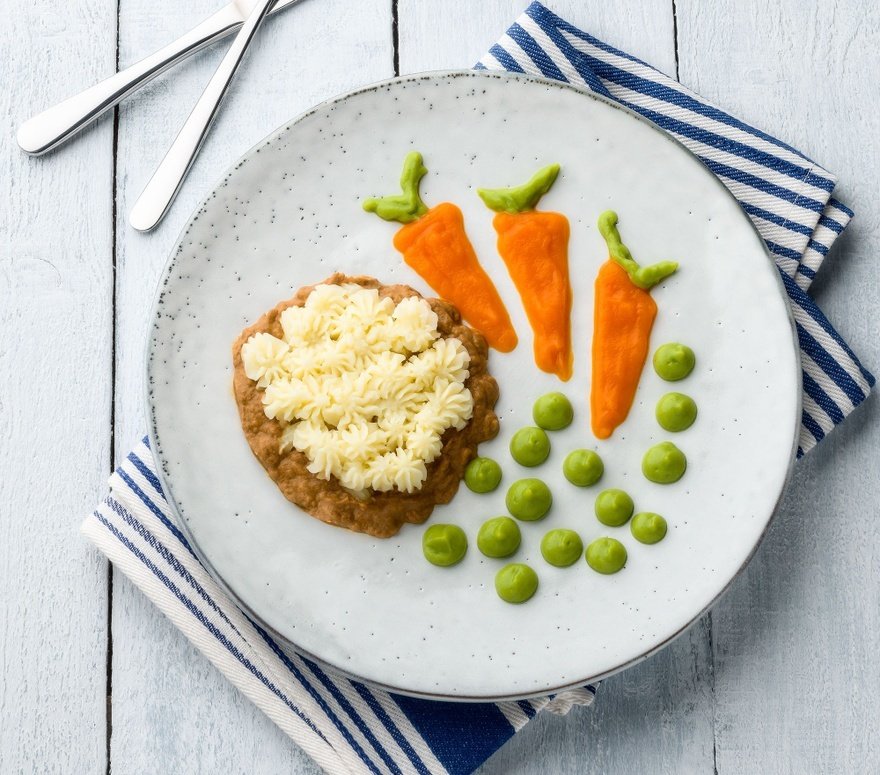Golden years: meeting the demands of the ageing 'rock 'n' roll' generation
The care home sector is upping its game to meet the changing demands of the ageing ‘rock 'n' roll' generation. Richard McComb reports
The UK care home business is big business – very big business – and it is about to get a whole lot bigger. The sector's £15.9b price tag reflects the 410,000 residents living in residential care, and rapid growth is forecast because we are living longer. The Office for National Statistics predicts a 36% growth in people aged 85-plus between 2015 and 2025, rising from 1.5 million to two million.
But the dramatic figures tell only part of the story. What they don't convey is the changing nature of the UK's ageing population, its shifting outlook and aspirations.
This is set to have a profound impact on foodservice providers working in the care home sector. An egg and cress sandwich might be acceptable now, but residents in five or 10 years' time may be more interested in a falafel wrap.
There is also the small question of value for money. The average cost of a residential care home was £32,344 a year in 2017-2018, rising to more than £44,000 when nursing care was added. Almost half (44%) of care home residents are fully self-funded, paid for from savings, pensions and property sales.
The remainder is funded by councils, the NHS and councils with third-party top-ups. When customers are paying more than £32,000 a year, they should expect a good-quality main meal at a time when they want to eat it – but the reality is often far from this ideal.
Most care homes offer hot meals at lunchtime, but 86% of people would prefer them at dinner time, according to a survey on behalf of contract caterers Elior UK. Mealtime flexibility is just one of the new challenges for service providers, alongside responsibilities for the health and wellbeing of residents.
Food in care home settings presents complex issues regarding dietary needs, such as allergies, food intolerances, dementia and dysphagia, which has seen increased demand for texture-modified food. Additionally, the age range of residents is significant, potentially spanning over four decades (from 60-plus).
Evolving food tastes
Neel Radia, chair of the National Association of Care Catering (NACC), says: "Regional, cultural, religious and lifestyle diets must always be considered. Just like other sectors of hospitality, the rise in demand for vegetarian and veganism has been experienced in the care catering sector, with the number of people choosing meat-free options increasing.
"Traditional dishes are now more likely to include pasta and rice, which is a huge shift from five to 10 years ago. While spicy or hot foods may not be as in demand in a care setting, there is a definite tendency towards strong flavours, such as fruity or creamy curries or sweet and sour flavours."
Radia points to the range of cuisines on show at the NACC Care Chef of the Year competition, where food costs for the two-course menus were £2.25 per head. The winning menu was pan-roasted cod, fondant potatoes, garden peas and vegetables with sauce vierge, and a dessert of white chocolate, lemon and thyme mousse with a rosemary shortbread with sherbet and raspberry.
If that sounds like the sort of food guests might expect at a holiday resort, it is no coincidence. "Generations that have grown up with easy access to leisure, hospitality and travel want a ‘hotel-style experience' that continues to reflect their lifestyle, including a 24/7 dining experience," says Radia.
"We're already seeing the change with à la carte menus in care homes and the growth of lifestyle-driven retirement living. Traditional care homes will become a thing of the past and care catering will have to evolve to meet changing client demands."
Caterplus, the specialist care catering arm of Elior UK, looked into the needs of the care sector's emerging ‘rock 'n' roll' generation for its report The Future of Care. The findings back the view of the NACC that residents want enhanced experiences – 84% say residential care facilities should resemble a home while offering hotel services.
According to the report, menu variety is the top priority for consumers when it comes to a care home's food offering. The top food choice was traditional British food (74%), followed by Italian (62%) and Chinese (54%).
Robin Givens, Elior UK managing director (contracts), says: "People want diversity in their dining experiences, from bespoke orders to all-day grazing, delivery and takeaway options, traditional family dining and pop-up food experiences.
"Café culture is an important part of socialisation and retaining independence in later life. Our research found that cafés are the most desired facility in care provisions – seven in 10 people expect to see a café, restaurant or bar that can be visited outside of mealtimes."
"The days of the nut roast are long gone"
Care caterers need to work closely with health professionals to ensure the needs of specialist groups, such as diabetics and people with dementia, are met. It is also important to remember that food is associated with safety, comfort and happiness, and mealtimes can be the highlight of a resident's day, according to Rob Owen, executive business development chef at Creed Foodservice.
Owen forecasts rising demand for vegetarian and vegan food in the care system as the current generation grows older. That said, it is vital for caterers to understand the nutritional requirements of vegetarian and vegan diets to ensure residents get a balanced diet. Building relations with suppliers, and tapping into their knowledge, is vital.
"The days of nut roast and quiche being the most exciting dish on a vegetarian menu are long gone, but for caterers not used to vegetarian cooking, it can be daunting," says Owen. "It is important to realise that when introducing vegetarian or vegan dishes there can be no compromise. This is particularly the case with residents suffering from dementia. If they are vegetarian or vegan, their wishes regarding animal products must be respected, even if they are no longer able to make choices for themselves. Check all the ingredients – even jelly, for example, as it can contain animal gelatine."
Iron and B12 deficiency, which can lead to anaemia, are the main concerns for vegan and vegetarian residents. Iron-rich dishes could include black-eyed peas, lentils, chickpeas, oatmeal, dried fruits, nuts, sunflower seeds, nutritional yeast, molasses and grains such as quinoa and millet.
Owen says: "Vitamin C helps increase iron absorption, so for optimal health benefits, dishes that are rich in dark green leafy vegetables, such as kale, work well. Many dishes can be created with plant-based proteins, too – potatoes, lentils, tofu and broccoli, for example.
"Rainbow heritage carrots and brightly coloured vegetables such as beetroot and red cabbage not only look good on the plate but are versatile in a range of recipes. ‘Beetburgers', made with beetroot and chickpeas, make a nutrient-packed vegan alternative."
People with dysphagia have varying problems when swallowing foods or liquids, and dysphagia is not a one-size-fits-all condition, says the chef. Care caterers should assess on an individual basis and work to the new International Dysphagia Diet Standardisation Initiative global classifications.
"When catering for residents with dysphasia, plenty of colour and texture is required to ensure that dishes are as appealing as they can be," says Owen.
"Ensuring that the presentation of a dysphagia meal is as realistic as possible is key to the resident's wellbeing, too. Presentation tips include separating each item on the plate. If you are recreating a roast dinner, each component should be puréed and presented individually. Or try layering dishes such as cottage pie or desserts in a glass dish."
Flower power for silver surfers
Traditional puddings and cakes evoke feelings of comfort and pleasure, and Dr Oetker Professional's Wellcare Range is a selection of custard, jellies, dessert and cake mixes, including a gluten-free sponge cake, with reduced sugar and no artificial colours, flavours or preservatives.
Emma Stamp, Dr Oetker senior brand manager, advises care home caterers to differentiate their offer with ‘flower power', incorporating botanical and herbal ingredients in bakes. "It's about capturing all the senses with natural ingredients, from fragrant rosemary and thyme to the floral notes of rose and elderflower," says Stamp.
Nostalgia remains a powerful draw and classic tray bakes offer a twist on afternoon tea. Talking of tea, a cuppa remains the most important drink for 62% of the ageing population, followed by filtered water and coffee, according the The Future of Care report. Residents in care homes drink an average of two to three cups of tea per day.
Michelle Jee, Tetley senior brand manager (out of home), says tea plays a key part in hydration best practice while delivering familiar comfort.
"With 37% of over-65s dehydrated on admission into care, it's crucial that care homes encourage good hydration practices," says Jee. But that doesn't mean operators should limit choice to traditional black tea. "There has been an explosion in green, fruit and herbal tea consumption, which are growing by 5.6% and 2.5% year-on-year respectively. It's crucial that residents in care homes are introduced to new flavours that aid in maintaining a healthy lifestyle through their hot beverage consumption," Jee adds.
Tetley's new Supers range comprises Super Green Tea Boost, Super Green Tea Immune and Super Fruits Boost, which include vitamin B6 that can reduce tiredness and support the immune system. Alternatively, Jacobs Douwe Egberts' range of Kenco specialities is an option to provide frothy coffee by just boiling a kettle.
As the care home population grows, operators also need to think carefully about kitchen design and future-proofing with bespoke maintenance plans. Tom Bartley-Smith, managing director of Sprint Group, which specialises in kitchen design, installation and maintenance, says: "Making and serving food is synonymous with care, and care homes present a unique challenge for chefs and catering managers, who have to use a tight budget wisely to produce food that's not only healthy and nutritious, but also visually appealing, both to residents and to their families."
Four key trends of care home catering
Fortifications
The use of protein over saturated fats. Milk powder, nuts, pulses and pea protein are all good ways to help residents maintain a healthy weight.
‘Nose-to-root'
More dishes will use every part of the animal or plant. The older generation always understood the need to tackle food waste – they call it practical housekeeping.
Flexibility
Choice at the point of service is critical. Expectations depend on the individual, dictated by what they are used to eating and where they come from as well as their life experiences.
Freedom
From communal family-style service with dishes placed on the table for residents to help themselves to people eating in their rooms, service has to be individually tailored.
Suppliers
- Caterplus www.caterplus.co.uk
- Creed Foodservice www.creedfoodservice.co.uk
- Elior www.elior.co.uk
- Jacobs Douwe Egberts www.jacobsdouweegbertsprofessional.co.uk
- National Association of Care Catering www.thenacc.co.uk
- Oetker Professional www.oetker-professional.co.uk
- Sprint Group www.sprint-group.co.uk
- Tetley Food Service www.tetleyfoodservice.co.uk
Continue reading
You need to be a premium member to view this. Subscribe from just 99p per week.
Already subscribed? Log In









